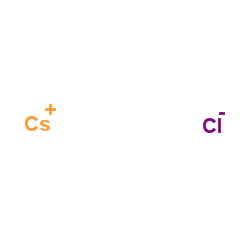Cesium chloride

Cesium chloride structure
|
Common Name | Cesium chloride | ||
|---|---|---|---|---|
| CAS Number | 7647-17-8 | Molecular Weight | 168.359 | |
| Density | 3.983 | Boiling Point | 1290 °C | |
| Molecular Formula | CsCl | Melting Point | 645 °C(lit.) | |
| MSDS | Chinese USA | Flash Point | 1303°C | |
| Symbol |

GHS08 |
Signal Word | Warning | |
Use of Cesium chlorideCesium chloride is a blocker of potassium channel. Cesium chloride prevents the decrease of Na+ transport produced by Alloxan[1][2]. Cesium chloride has induced cardiac arrhythmias, including torsade de pointes in animal models[3]. |
| Name | caesium chloride |
|---|---|
| Synonym | More Synonyms |
| Description | Cesium chloride is a blocker of potassium channel. Cesium chloride prevents the decrease of Na+ transport produced by Alloxan[1][2]. Cesium chloride has induced cardiac arrhythmias, including torsade de pointes in animal models[3]. |
|---|---|
| Related Catalog | |
| In Vitro | Cesium chloride (CsCl) decreases the increment of membrane potential, the elevation of intracellular calcium and the upregulation of NOS, ET-1 and VEGF expressions, which are induced by Acrolein[3]. |
| In Vivo | Cesium Chloride (12 mg/100 g body weight, daily for 30 days; i.p.; male Wistar rats- BOO model) could significantly weaken the effect of XJT (traditional Chinese medicine) on not only the expression of these potassium channels but also the bladder weight, urodynamics, and oxidative stress[1]. |
| References |
| Density | 3.983 |
|---|---|
| Boiling Point | 1290 °C |
| Melting Point | 645 °C(lit.) |
| Molecular Formula | CsCl |
| Molecular Weight | 168.359 |
| Flash Point | 1303°C |
| Exact Mass | 167.874298 |
| Index of Refraction | 1.6418 |
| InChIKey | AIYUHDOJVYHVIT-UHFFFAOYSA-M |
| SMILES | [Cl-].[Cs+] |
| Stability | Stable. Deliquescent. Incompatible with strong oxidizing agents, strong acids. Protect from moisture. |
| Water Solubility | 1860 g/L (20 ºC) |
CHEMICAL IDENTIFICATION
HEALTH HAZARD DATAACUTE TOXICITY DATA
MUTATION DATA
|
| Symbol |

GHS08 |
|---|---|
| Signal Word | Warning |
| Hazard Statements | H361 |
| Precautionary Statements | P280 |
| Personal Protective Equipment | Eyeshields;Gloves;type N95 (US);type P1 (EN143) respirator filter |
| Hazard Codes | Xn:Harmful |
| Risk Phrases | R68 |
| Safety Phrases | S36/37-S26 |
| RIDADR | 2923 |
| WGK Germany | 2 |
| RTECS | FK9625000 |
| HS Code | 28273980 |
| HS Code | 28273980 |
|---|
|
Adenoviral-mediated gene transfer of insulin-like growth factor 1 enhances wound healing and induces angiogenesis.
J. Surg. Res. 190(1) , 367-77, (2014) Chronic wounds are characterized by a wound healing and neovascularization deficit. Strategies to increase neovascularization can significantly improve chronic wound healing. Insulin-like growth facto... |
|
|
Analysis of triacetone triperoxide complexes with alkali metal ions by electrospray and extractive electrospray ionisation combined with ion mobility spectrometry and mass spectrometry.
Eur. J. Mass Spectrom. (Chichester, Eng.) 21 , 265-74, (2015) The complexation of triacetone triperoxide (TATP) with a range of alkali metals has been studied by electrospray ionisation-mass spectrometry yield [M+Cat](+) ions for all of the alkali metals. The fo... |
|
|
Coat Protein-Dependent Behavior of Poly(ethylene glycol) Tails in Iron Oxide Core Virus-like Nanoparticles.
ACS Appl. Mater. Interfaces 7 , 12089-98, (2015) Here we explore the formation of virus-like nanoparticles (VNPs) utilizing 22-24 nm iron oxide nanoparticles (NPs) as cores and proteins derived from viral capsids of brome mosaic virus (BMV) or hepat... |
| EINECS 231-600-2 |
| cesium,chloride |
| MFCD00010955 |
| Cesium chloride |

